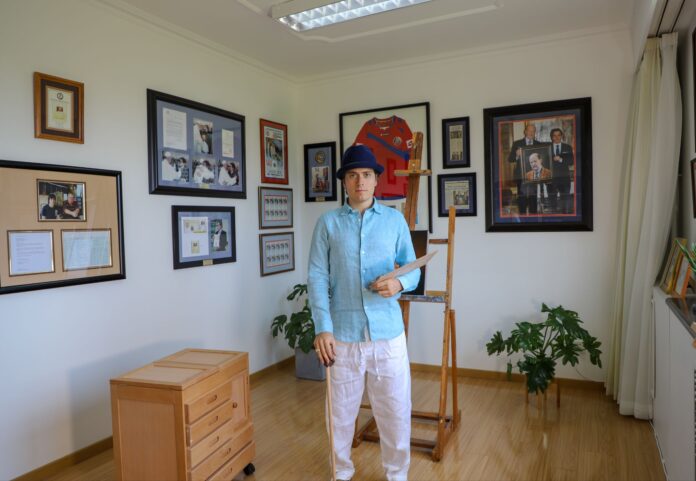Since graduating from Carleton University’s architecture program in 2010, Juan Manuel Delgado has whisked around the world and back.
Originally from Costa Rica, Delgado is a dedicated artist and educator who has painted several influential figures, including Pope Francis, King Simeon II of Bulgaria and NASA astronaut Franklin Chang-Díaz. He is currently a professor at Hebei International Studies University in China.
Eight years after the Charlatan wrote about his portrait of Pope Francis, Delgado sat down with the Charlatan once again to offer a glimpse into his career.
The Charlatan (TC): How has your time at Carleton influenced your career path, work ethic and artistic skills?
Juan Manuel Delgado (JMD): When I was three, I moved to Canada from Costa Rica. Since I was young, I studied art with Peter Schwartzman, a Russian artist and architect, who persuaded me to pursue an architecture degree. He showed me techniques ranging from charcoal drawing to pencil drawing and was a big influence prior to entering Carleton.
My father studied political science at Carleton, and I decided to continue that family legacy by studying architecture at Carleton. It has built a great foundation, particularly because of the program’s focus on the technical aspect of drawing. As I transitioned into my artistic career, that focus helped. Discipline, work ethic and great professors led me to success at Carleton.
TC: What about painting portraits resonates with you?
JMD: Painting has always been something important to me. Portraiture is the most difficult style of painting because it involves a lot of technical skills. For example, in terms of mixing colours, there isn’t one universally accurate flesh tone one can buy. I enjoy the difficulty that comes with mixing tones, values and colours together.
I also like interacting with the person I am painting. Your focus should go beyond capturing their appearance. As Rembrandt said, you want to capture their essence, their spirit. You want to have that invisible dialogue between the portrait and the spectator viewing the portrait. And so, that’s what I try to capture. I want to meet influential people from around the world and have that dialogue, which will hopefully leave a mark on history. Worldwide, portraits are seen as a legacy of the past that captures the essence of the moment and will transcend future generations.
TC: What is your creative process? How do you choose the subjects for your portraits?
JMD: If not directly commissioned, then it’s more spontaneous. I like to walk around and just let things happen naturally. If I see someone on the street who captures my eye, then I ask to paint their portrait or do a figurative painting. I love spontaneity, and I think it gives an essence of mystery to the painting. It’s not something fabricated. Everyone has their own sense of beauty in the world.
TC: What has your artistic career included these past few years?
JMD: The painting of Pope Francis was very significant for me. As I’m Costa Rican, and Latin America is Catholic, that moment was very important to my country. The year after that, the Costa Rican post office circulated a stamp using my painting to commemorate Pope Francis’ first year of pontificate.
Since then, I’ve painted several portraits of presidents, sports stars, celebrities, dignitaries, prime ministers and ambassadors. Most notably, I am one of the youngest artists in history to paint an official portrait of a King. I painted King Simeon II of Bulgaria in 2014. I had almost an hour-long private meeting with him and it was very interesting to have that dialogue and to visit his castle.
TC: Since 2021, you’ve been an appointed professor at Hebei International Studies University in China. How has that experience been?
JMD: As a distinguished professor, I have given country-wide lectures talking about my work, career, Costa Rica and Canada. I definitely hold both nations as important in my life. Teaching can provide cultural exchanges and bilateral relationships between countries, which are important.
I have met many great Chinese artists who have opened my eyes to a different world. I have met presidents from world peace foundations and conducted projects with the United Nations. I did an exhibition in Shanghai for the 75th anniversary of the United Nations Cultural Exhibition, where I talked about the importance of art as a foundation to unite different cultures and nations. Most recently, I had a similar meeting with UNICEF to bring awareness about using art as a tool to discuss global issues.
Coming from a country with no military, I want to use my art as a voice. Art is a universal language and is understood by everyone. There should be no racism or conflict within art. It’s something that brings a shared community together.
TC: What’s next for you?
JMD: I was just in Mexico exhibiting at a museum called the Zanbatha, Museo del Valle de la Luna. Mexico is a culturally rich country and it was meaningful for me to exhibit at such a prestigious museum. I can see the love of art that Mexico has.
Right now, I’m focused on exhibiting at different museums and hopefully will do so in Canada. I am definitely interested in creating an exhibition with both Costa Rican and Canadian cultures. From an educational aspect, I hope to continue to share my experiences and everything I have learned.
This interview has been edited for length and clarity.
Featured image provided by Juan Manuel Delgado.






